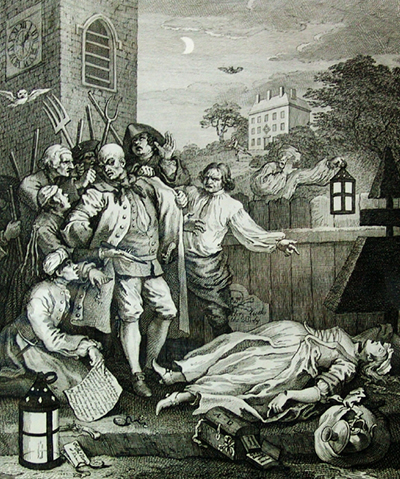Cruelty in Perfection was the third print of four in the series The Four Stages of Cruelty by William Hogarth. Published in 1751 they represent the satirical art of the time, inspired by the cruelty Hogarth saw around him on the streets of London, particularly to animals.
The chief protagonist is Tom Nero and the series charts his life from abusing animals to being a thief before murdering his pregnant lover, Ann Gill, the scene depicted in Cruelty in Perfection. Measuring 38.7cm by 32.4cm the plate is an etching of the gruesome scene as Tom Nero is apprehended.
Cruelty in Perfection shows a grotesque representation of Tom Nero as he is arrested. The body of the murdered Ann Gill lies at his feet, her throat slit, with items scattered around her which she had stolen from her mistress at Nero's bidding. The etching portrays the brutality of the murder, capturing it all within a foreboding scene. Set within a cemetery at night with a bat flying above, the etching conjures up imagery to magnify the macabre situation and heighten the innate fears of the viewer. Ann Gill has left a letter for her murderer, while she is also pointing to the words on a nearby book stating "God's Revenge against Murder".
Hogarth's prints were to spread across Europe, influencing how books in France and Germany in particular were illustrated. He would also influence many subsequent caricaturists right through to the 20th century. He had a huge influence on John Collier, an English caricaturist and poet, who styled himself as the Lancashire Hogarth. Collier's etchings lampooned all classes of people and he also went by the pseudonym Timothy Bobbin. William Hogarth's moral art was to have an influence on the pre-Raphaelite brotherhood too, consisting of painters and poets including William Holman Hunt and John Everett Millais.
Prints of Cruelty in Perfection as part of a series of four were aimed towards the lower classes in the London streets which Hogarth knew well. They were meant as warnings against amoral behaviour and did not rely on subtlety. He wanted his target audience to understand his meaning. Exhibitions at galleries like the Tate have given people today the chance to observe these etchings and view the 18th century moralistic satire these prints represent.




